Video of the Week:
Eggplants: When to Harvest
Vegetables:
Tomato Leaf Spot Diseases
Septoria leaf spot usually appears earlier in the season than early blight and produces small dark spots. Spots made by early blight are much larger and often have a distorted “target” pattern of concentric circles. Heavily infected leaves eventually turn yellow and drop. Older leaves are more susceptible than younger ones, so these diseases often start at the bottom of the plant and work up.
Mulching, caging, or staking keeps plants off the ground, making them less vulnerable. Better air circulation allows foliage to dry quicker than in plants allowed to sprawl. Mulching also helps prevent water from splashing and carrying disease spores to the plant.
In situations where these diseases have been a problem in the past, rotation is a good strategy. It is too late for that now, but keep it in mind for next year. Actually, rotation is a good idea even if you have not had problems in the past. But many gardens are too small to make it practical. If you have room, rotate the location of the tomatoes each year to an area that has not had tomatoes or related crops (peppers, potatoes, eggplant) for several years.
If rotation is not feasible, fungicides are often helpful. Be sure to cover both upper and lower leaf surfaces, and reapply fungicide if rainfall removes it. Plants usually become susceptible when the tomato fruit is about the size of a walnut. Chlorothalonil is a good choice for fruiting plants because it has a 0-day waiting period, meaning that fruit can be harvested once the spray is dry. Chlorothalonil can be found in numerous products including Fertilome Broad-Spectrum Landscape and Garden Fungicide, Ortho Garden Disease Control, GardenTech Daconil and others. Be sure to start protecting plants when the disease is first seen. It is virtually impossible to stop it on heavily infected plants.
If chlorothalonil doesn’t seem to be effective, try mancozeb (Bonide Mancozeb Flowable). Note that there is a five-day waiting period between application and when the fruit can be harvested. You may wish to pick some tomatoes green just before you spray if you use Mancozeb as they will ripen inside. (Ward Upham)
Onions Developing
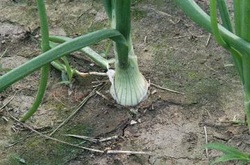
A gardener can tell when onions are nearing harvest time by some of the tops falling over. You may wish to break over the tops that haven’t fallen to encourage drying of the neck. Allow a few days to pass and then dig the onions to insure they don’t sunburn. Temporarily store them in a dry, well-ventilated area for a week or two before cutting the tops to insure the necks are completely dry. Remove the foliage (or braid the leaves) and store in a cool, dry location. (Ward Upham)
Flowers:
Rose Rosette
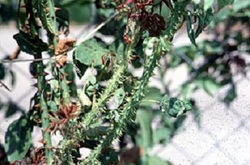
Infection is thought to start with rapid elongation of a new shoot. The rapid shoot growth may continue for several weeks to a length of two to three feet. Following shoot elongation, a witches' broom or clustering of small branches occurs. The stems develop excessive thorniness and produce small, deformed leaves with a reddish-purple pigmentation. Stems and petioles of Rosa multiflora plants may have reddish blotches or streaks. Rose plants infected with the rose rosette virus die rapidly, usually within one to two years.
Rose rosette is caused by an Emaravirus species. Transmission of the disease has been shown experimentally through grafting and is also thought to be spread by mites. Though KnockOut roses are resistant to many diseases, they are susceptible to this one.
There is no effective control measure for infected plants. In garden settings, infected plants should be removed and destroyed, including roots. Any roots that remain after plant removal may produce infected shoots which can harbor the disease.
If possible, eliminate all multiflora rose plants from the vicinity as they are extremely susceptible and will act as a carrier. Multiflora rose is the wild rose often seen growing in ditches and pastures. Since the disease can be transmitted by pruning shears, disinfect the shears when moving from one plant to another by using rubbing alcohol or a disinfectant such as Lysol. (Ward Upham)
Ornamentals:
Herbicide Damage to Trees, Shrubs and Gardens
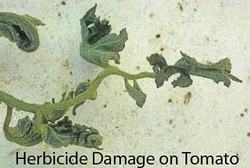
Broadleaf herbicide drift. A number of herbicides used on farms and on home lawns are essentially plant growth hormones. These include 2,4-D, triclopyr, and dicamba and are commonly used to control broadleaf weeds in lawns, pastures, or grassy crops. These products may become a gas (volatilize) at high temperatures, causing them to drift and damage nontarget plants such as trees and shrubs. Symptoms may include twisting and distortion of plant foliage, leaf yellowing, and, in severe cases, branch dieback. One of the trademark signs of this damage is the curly-Q twisting of leaf petioles or stems. Though tomatoes, redbud trees, and grapes are sensitive to these herbicides, a number of species will show some damage if drift has occurred. If you see twisting on more than one species, chances are that herbicide drift has occurred. Often, plants recover from drift due to volatilization.
Damage to vegetable gardens. Though drift is the most common cause of herbicide damage on vegetables, other potential problems exist as well. Cattle fed prairie hay from pasture treated with picloram (Tordon) can have manure tainted with the herbicide. If this manure is used on a vegetable garden, plants may sicken and die. Also, lawn clippings treated with quinclorac (a crabgrass killer) and used as mulch can have the same effect. Both products can remain active for up to 24 months.
Damage from stump or sprout treatments. Tree stumps often are treated to prevent resprouting. Two commonly used products are picloram (Tordon) and triclopyr (Remedy, Stump Killer, Brush-B-Gon, etc.). Be careful when applying these herbicides to prevent contamination of the soil. Nearby trees may be damaged if they pick up enough herbicide. Foresters warn that picloram also may leach from roots of a treated tree into the soil and be absorbed by roots of another tree species. This does not occur with triclopyr. Be very careful about using these products near valuable trees and shrubs.
Sprouts are often treated to keep them from growing where they interfere with the aesthetics of a lawn or other landscaped area. Never use a herbicide to treat sprouts coming from a root system of a tree you want to keep. A number of tree species including honey locust, black locust, hackberry, western soapberry, persimmon, and occasionally, maples may send up sprouts from their roots.
Treating these sprouts will effectively treat the tree to which they are attached. This may ultimately kill the tree. Also remember that trees of the same species growing next to one another may share a root system as a result of root grafting. Treating one tree in the group is like treating all of the trees.
If treating volunteer sprouts, use a product such as Monterey Sucker-Stopper. It will not harm the plant to which the sprouts are attached.
Liquid Weed Edgers. Herbicides are often used along fences, on sidewalks or gravel drives to prevent plant growth. Some of these, including glyphosate (Roundup) and glufosinate (Finale) rarely causes damage unless sprayed directly on the foliage of a shrub or tree. Other liquid weed edger products are soil sterilants and have a long residual (months to years) in soil and are highly toxic to trees and shrubs. Symptoms may include yellowing, marginal leaf scorching, branch dieback and tree mortality. Once the tree takes up these products through their roots, they suffer permanent damage. Never use these soil sterilants in areas where tree roots may be exposed. Remember that tree roots extend well beyond the drip line. It is almost impossible to use liquid weed edgers in the landscape without coming in contact with tree roots. Also remember that some of these products, such as prometon, will move with water until they become affixed to the soil. (Ward Upham)
Pests:
Squash Bugs
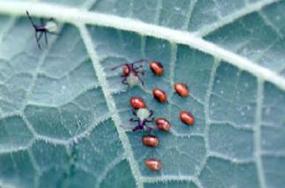
Because squash bugs feed by sucking juice from the plant, only insecticides that directly contact the insect will work. General use insecticides such as permethrin (Bug-B-Gon Multi-Purpose Garden Dust, Green Thumb Multipurpose Garden and Pet Dust, Bug-No-More Yard and Garden Insect Spray, Eight Vegetable, Fruit and Flower Concentrate, Garden, Pet and Livestock Insect Control, Lawn & Garden Insect Killer), malathion, and methoxychlor provide control if a direct application is made to young, soft-bodied squash bugs. This means that you MUST spray or dust the underside of the leaves because this is where the insects live. (Ward Upham)
Hackberry Caterpillar Butterflies
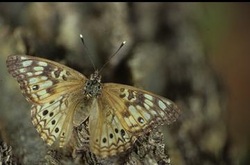
Exact reasons to explain outbreaks are unknown. An often-cited reason to explain them is the mildness or severity of the previous winter. This breaks down, however, if one looks at a relatively limited geographical area experiencing a spate of hackberry butterflies, against other areas which experienced the same winter conditions ---- which begs the question, “Why here and not there?”
The definitive work done by C. V. Riley in Missouri )1874( documented that hackberry butterflies produced 2 generations per year, with the larvae emerging from the eggs of second generation moths being the overwintering form. Based on this, there would be little reason not to expect the same 2 generation scenario in Kansas. So what is the commotion about regarding hackberry caterpillar butterflies? It is the butterfly themselves, as well as the impact of larval activities.
The presence of the larvae precedes that of the butterflies. The head of the larva has an interesting look: a black horned appearance.
In the absence of people, hackberry caterpillars go about their business without causing concern. However when people decide to “invade” the domain of hackberry caterpillars, a couple of situations occur. First, if picnicking beneath hackberry trees in which caterpillars are feeding, the rain-of-fecal pellets can be unappetizing.
Second, after caterpillars have completed their feeding up in the canopy of hackberry trees, they descend to the ground in search of a site in which they will pupate. This stream of caterpillars (again in the presence of people) may be disconcerting.
Tremendous numbers of larvae translate into eventual tremendous numbers of butterflies. Thus, the “nuisance factor” continues upon completion of pupation and the emergence of the “new” butterflies. (Bob Bauernfeind)
Elm Flea Weevil in Kansas
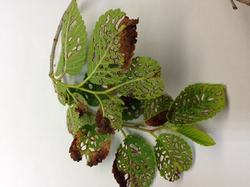
The adult of this insect is a very small (1/8 inch) brown weevil with dark spots on the back. It sports a short, curved snout and has the ability to hop.
Eggs from overwintering adults hatch on newly formed leaves. The larva produces a serpentine pattern in the leaf that terminates on a leaf edge. Adults have emerged now and are feeding on the leaves. Adult feeding damage produces a shothole pattern in the leaves. Heavily fed upon leaves appear lacy. There is one generation per year and so when the adults disappear, there should be no further damage this year.
I have not seen any control strategies for this insect. Trees typically recover from spring defoliations. (Ward Upham)
Miscellaneous:
Recent Rains Trigger Mushrooms
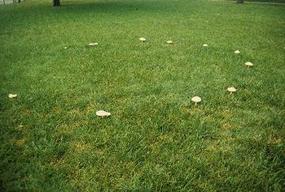
Unfortunately, the thick fungal mat formed by the fairy ring fungus interferes with water infiltration. The fungus also may release certain byproducts that are toxic to the turf. This can lead to dieback of the turf close to the ring. Fairy rings are difficult to control. You can sometimes eliminate the ring by digging to a depth of 6 to 12 inches and 12 inches wide on both sides of the ring, refilling the hole with non-infested soil. Or you can try to mask the symptoms by fertilizing the rest of the lawn so that it is as dark green as the ring. This often isn't a good idea because it tends to promote other turf problems. Commercial people can use certain fungicides to control fairy rings but these products are not available to homeowners. See http://www.ksre.ksu.edu/bookstore/pubs/EP155.pdf for more info on these fungicides.
Some mushrooms in lawns are not associated with fairy rings. These may be mycorrhizal (symbiotic association with tree roots) or saprophytic (live on dead organic matter such as wood, etc.) in the soil. Because some of these mushrooms are beneficial, you don't really want to kill them. Besides, a fungicide spray to the mushroom itself does little good. Remember the mushroom is simply the fruiting structure of the organism. Most of the fungus is below ground and inaccessible to the chemical. If mushrooms are a nuisance, pick them and dispose of them as soon as they appear. Also, remove sources of large organic debris from the soil. Also, mushrooms tend to go away as soil dries. Patience may be the best control. Some of the mushrooms in the lawn are edible, but others are poisonous. Never eat mushrooms unless you are sure of their identity. (Ward Upham)
Contributors: Bob Bauernfeind, Entomologist; Ward Upham, Extension Associate
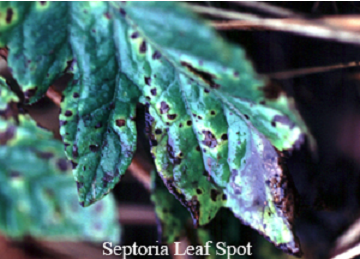
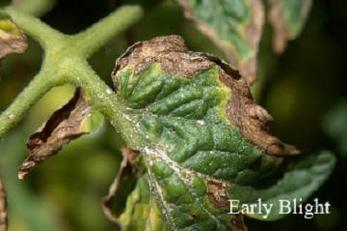
 RSS Feed
RSS Feed
